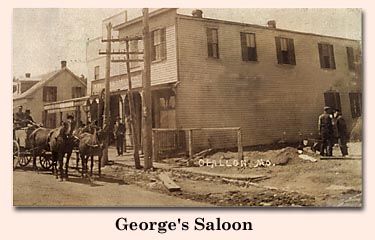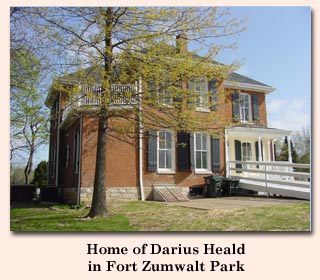Life in these prairie towns was full of hard work, and with neighbors often
miles away things could get lonely. As O'Fallon's population increased in number and
prosperity, folks could begin to turn their attention to their social lives.
Mill Pond

In the early 1900's a mill pond (named such because of its proximity to the
old elevator) in the 200 block of South Main Street supplied ice in the winter and water for hand
cranked fire hoses in the city. It also served as a major source of recreation for the
people of O'Fallon. When the pond froze in winter, folks enjoyed ice skating with a
nearby bonfire provided warmth for skaters. In the summer, people enjoyed fishing in the
pond. The pond was drained in November of 1944.
Taverns
No movie depicting a town in the wild, wild West would be complete without a
saloon or two and O'Fallon was no exception. It's been said that O'Fallon had more churches
and taverns than anything else and though the taverns changed names and owners throughout the years,
they were all located a stone's throw from each other just south of the railroad tracks on Main
Street.

It must be understood that, even through the 1960's, the taverns in O'Fallon
were family gathering places. No doubt some troubling behavior occurred from time to time
in the late evening hours. Still, entire families came to the tavern for food and drink
and to visit with friends. The taverns were also the gathering pace for O'Fallon's civic
leaders and many new ideas and plans for improving the city were devised and debated at their
tables.
Talleur Hall/VFW Hall
Talleur Hall was located near the Mill Pond and is probably most notable
for the fact that it was funded and built by a woman, Mrs. Caroline Talleur. Her home was
situated on the southwest corner of Main and West Elm and her family owned a fair amount of property
in O'Fallon. Talleur Hall provided moving pictures for the enjoyment of the people of this
prairie town and in later years was the scene of dance recitals, wedding receptions and productions
of all kinds. In 1946, the V.F.W. purchased the building, using it for their meetings and
renting it out for special events of all kinds.
O'Fallon Civic Club and Civic Hall
The O'Fallon Civic Club was organized by local businessmen, farmers and
civic-minded citizens in October of 1938 for the purpose of promoting and advancing ideas to make
O'Fallon a better and more progressive city in which to live. In the late 1930's,
Assumption Church sold the land now known at Civic Park to the City of O'Fallon for the sum of one
dollar. Under an agreement reached with the sale, the church continued to use the park for
their annual parish picnic until the mid 1980's. The park provided play equipment and
picnic grounds and eventually a concrete dance floor was added. During the summer months
of the 1950's, bands provided music and dances were popular for fund-raising and social
events. The Civic Club also provided a softball park on the north side of East
Elm. Volunteers installed poles and light fixtures for night games. An Honor
Roll was erected near the ballpark to honor the veterans of World War II.
In 1958, funds raised from the Centennial Celebration of 1956 were used
to build Civic Hall, where only a concrete dance floor once was, as part of a city-wide Planned
Progress Initiative.
The Public Library
In the early 1960's a group of interested citizens in O'Fallon met and
organized a committee to promote interest in the establishment of a library district. As
a result of their efforts, in 1963 the Missouri State Library agreed to provide a bookmobile
demonstration program to determine the level of local interest. As quickly as 1964,
residents approved the establishment of a county library district and the tax levy needed to support
it. On August 4, 1964, the O'Fallon Branch Library opened its doors in a storefront on
South Main Street. The following year the library moved to larger quarters in the
O'Fallon Plaza. Madelyn Bussinger was O'Fallon's first librarian and served the community
in that job until her retirement in 1985.
Parks
Civic Park is the oldest park in O'Fallon and is part of the land Nicholas
Krekel purchased from his brother, Arnold, in 1856. He gave the land where the park is
today to Assumption Parish in the early 1900's so the church could grow and expand.

When the church sold a portion of that land back to the city in the late 1930's, O'Fallon's first
city park was created. Civic Park is home to Civic Hall, Alligator Creek Aquatic Center,
the Bandstand and the O'Fallon Historical Society's Log Cabin Museum.
After Darius Heald's death, the land surrounding Zumwalt's Fort had a
succession of owners and over the years, the remains of this historic site fell into disrepair and
all but disappeared. Fort Zumwalt Park became part of the O'Fallon Parks system in 1978
when the State of Missouri sold the forty-eight acre park to the city for $1.00. The
O'Fallon Community Foundation is making a concerted effort to raise the funds necessary to rebuild
Zumwalt's Fort.
Fort Zumwalt Park also features Lake Whetsel and is home to the City's annual
month-long Celebration of Lights.
In Conclusion:
The O'Fallon Historical Society was organized in 1974 and its first officers
were installed on July 4th. In 1976 as O'Fallon celebrated the country's Bicentennial,
a log cabin previously owned by the Patton family was threatened by economic development. The
Historical Society, under the direction of Bill Westhoff and Raleigh Jessup, dismantled the log cabin
piece by piece and reconstructed it in Civic Park. The Log Cabin now serves as the museum
and meeting place for the O'Fallon Historical Society.